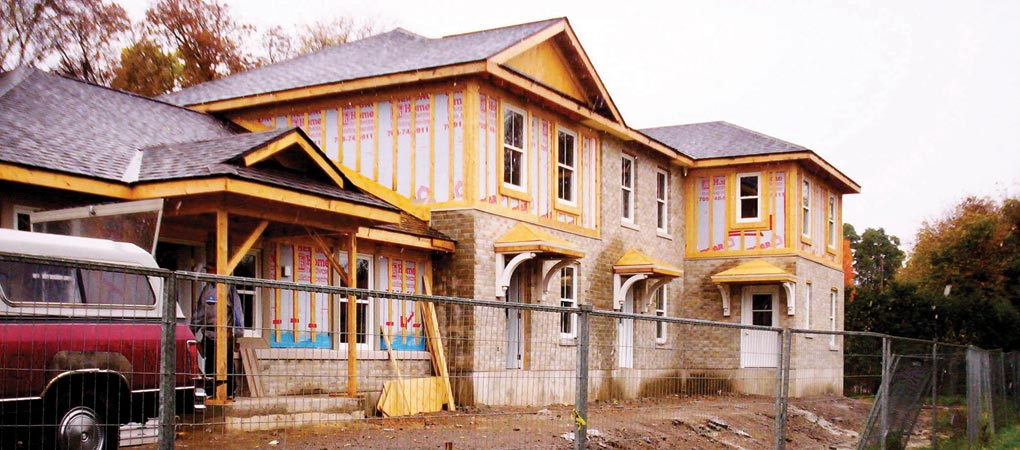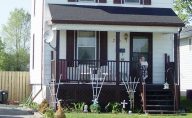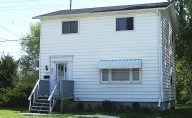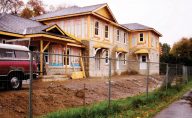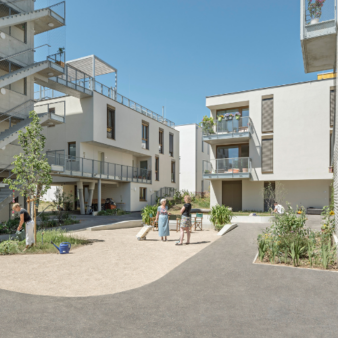The Peterborough Community Housing Development Corporation, now known as Homegrown Homes (HH), is a grassroots not-for-profit organisation started by two local people and incorporated in 1998 with a mandate to provide accessible, sustainable housing for low-income individuals and families as well as carrying out a range of other supporting activities. The principal activity of Homegrown Homes is to acquire and renovate older, city centre buildings, and then rent them to low-income families and individuals without relying on the public budget thanks to its diversified income sources and the participation of prisoners in the building process. Prisoners are building their capacity to reintegrate society and new buildings are also offering an affordable and dignifying environment for vulnerable members of Peterborough City with an almost inexistent rate of evictions. The practice is currently getting greater visibility in other cities in Ontario.
Project Description
Aims and Objectives
The goal of HH is to provide well-maintained, safe and comfortable accommodation at rents that are at least 15 per cent less than market rents for equivalent housing.
Context
Peterborough City, with a population of 74,000 is located 135 km northeast of Toronto. It stands just outside the northern tip of Ontario’s golden horseshoe, which is close enough to drive up house prices. Most homes constructed since 2003 have been single detached, starting at a cost of CA$205k (US$196k); a study in 2006 showed that supporting a bachelor apartment required an hourly wage of CA$10.85 (US$10.36), and more than 1,500 families were on waiting lists for subsidised housing in the city. The median income of renters is CA$28.5k (US$27.2k) compared to CA$65k (US$62.1k) for owners. Currently 36 per cent of occupied dwellings are rented and there is an acute local need for low-rent affordable housing with more than half of tenants spending more than 30 per cent of their income on rent. In the Province of Ontario all of the financing and administration of subsidised housing stock that existed in 1995 is the responsibility of the municipalities. This has created a challenge for municipalities who have to fund this stock from their property assessment income and have little surplus resource to increase the stock of social housing in the city.
Key features
HH provides low-rent housing for those at the lower end of the income spectrum. These tenants include seniors, families and individuals with varying abilities and needs, some of whom are working and others not. As of November 2009, HH was housing 53 people in 21 affordable rental units. Seventeen of the 53 tenants live in accommodation units which are leased to organisations whose clients have special needs, including those with learning difficulties, ex-offenders and homeless youth moving between shelters and transitional housing. The majority of these units are older buildings that have been renovated and converted, but six new-build units have also been provided.
HH’s first project was a City-owned derelict house on Parkhill Road, where HH proposed that it use the CA$10,000 (US$9,656) that the City would have to pay for demolition to renovate the building as a duplex. It secured funding to complete the renovations, but did not have enough money to buy the property outright. It proposed, instead that the City donates the land with a ‘reversionary interest’, i.e. essentially a condition that the land be used for affordable housing; otherwise, the City could reclaim it. Since the City was responsible for paying the mortgage if HH defaulted, the land could not encumber for more than a set amount (initially CA$25k, US$23.9k) without the City’s written permission. This agreement held enormous potential for other projects: it allowed HH to renovate and manage properties on the community’s behalf – an approach that became known as ‘Ingenuity in Action’.
The flexibility of the arrangement also prompted HH to leverage its partnerships with local businesses, non-profit organizations and volunteers to make each new home affordable, without ongoing subsidies. Some of these projects include: moving a derelict house to a vacant lot provided by the City; renovating a former crack house into a family dwelling, using funds from a private donation and converting a former church property into a six-bedroom home for older single women, with one wheelchair-accessible room. Each of these projects depended on a unique combination of grants, donations and in-kind support from HH’s network of partners. Volunteers play a key role in the work at Homegrown Homes, which helps to reduce costs and provides a higher quality product for the tenants. As well as individuals from a wide range of socio-economic groups the volunteers also include work teams from federal and provincial prisons, secondary schools and colleges, local churches and the Rotary Club. HH attempts to follow the principle of ‘think big: act small’ and develop one project at a time.
Covering costs
Capital for the purchase of land and properties comes primarily from the municipality using a range of capital subsides or reduced cost. Since 2005 a fundraiser has been seconded to HH by Ontario Trillium Foundation which has enabled it to increase its income from grants from foundations and other funding agencies. The fundraising programme now includes at least six annual events as well as selling a locally based popular board game and offering naming opportunities for corporate and individual sponsors. With the cooperation of its bankers, creative ways have been found to use HH assets to finance new acquisitions and increase rental income.
From August 2009 HH has accessed funding from the federal Affordable Homes Initiative which has provided CA$280k (US$270k) towards the cost (approx. one third of total cost) of its latest project at 202, Edinburgh Street.
Keeping building costs as low as possible requires an enormous effort from the board and staff and significant in-kind contributions from the community. Donations and a variety of grants are needed to further reduce costs.
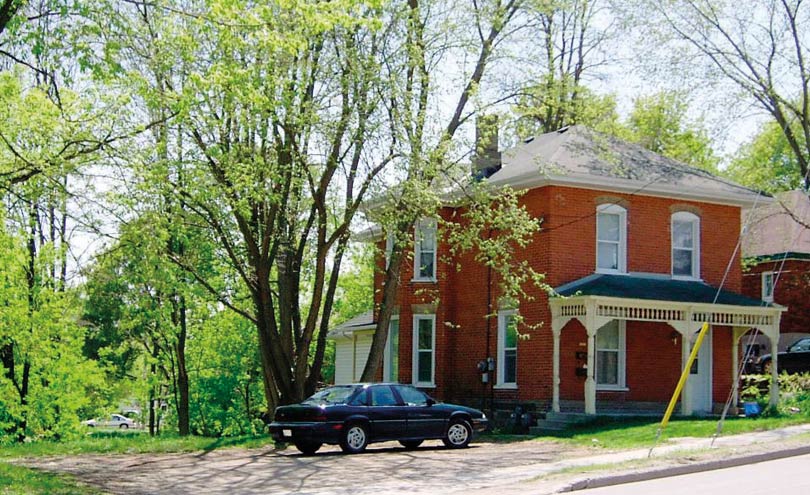
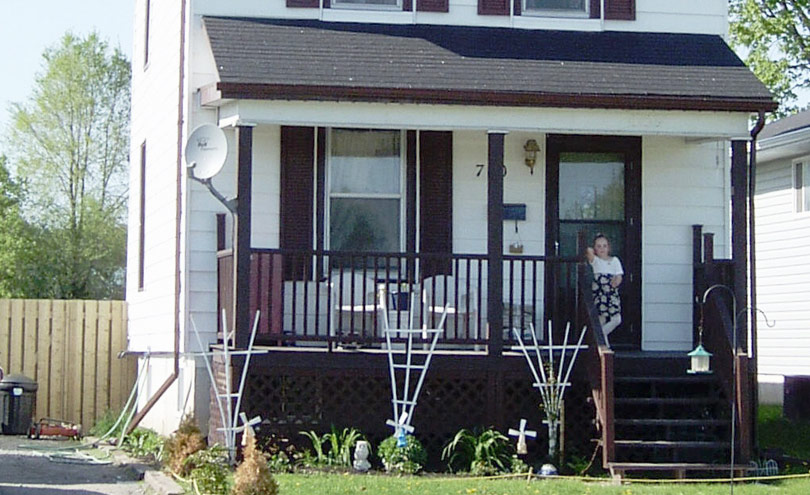
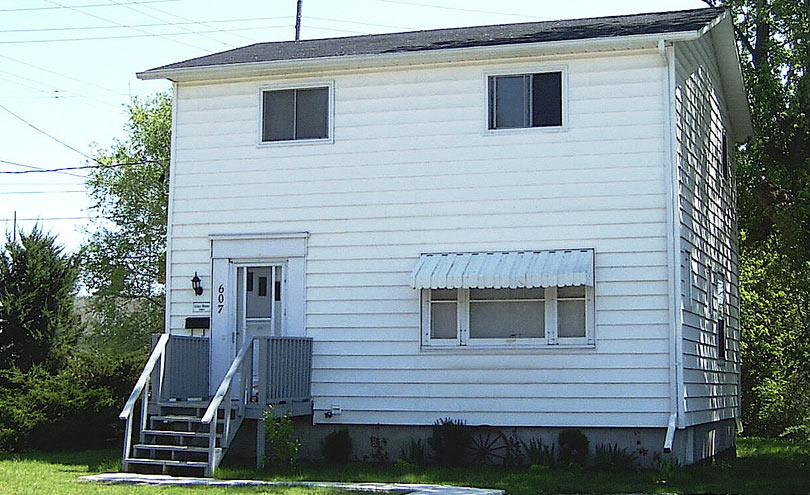
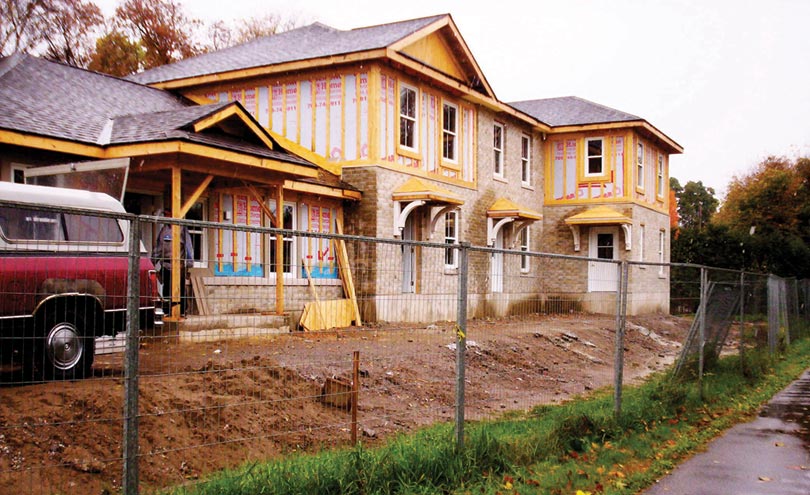
Impact
- The existing residents have a lower level of rent and a landlord who is interested in their wellbeing.
- The HH approach has been widely featured in the local press, at conferences etc, and HH has been invited by the municipality to participate in the development of its affordable housing strategy.
- As well as media coverage, HH has influenced the work of the municipality as it tries to provide affordable housing. HH board members were involved in establishing the policy of the municipality, in particular the Taking Charge Policy, which provided incentives for affordable housing providers. Fundraising events and opportunities for board members to speak at meetings of local groups provide ways of educating the community about the need for decent housing.
Why is it innovative?
- HH is the only non-profit rental housing provider in Peterborough operating without any government revenue subsidy and managing to keep rents at least 15 per cent lower than the market rate, and often much lower.
- Use of reversionary agreements to gain access to municipal land. This is where the municipality retains ownership of the land for 15 years, but allows HH to use this land as an asset. Financial institutions accept these land assets as collateral for further financing. It is hoped that over time these pieces of land could form the basis of a community land trust.
- At a time when senior levels of government are not willing to develop housing strategies that include ongoing subsidies for tenants, HH has developed a non-profit social enterprise that continues to grow, remain independent of government, work with leading service agencies and through fundraising and volunteers demonstrate that housing low income citizens is the responsibility of the whole community.
- HH holds and manages land and other assets on behalf of the community in order to promote both self-sufficiency in affordable housing as well as social, economic and environmental benefits for the community.
What is the environmental impact?
- In addition to conventional insulating methods, the exterior walls of some buildings have been filled with brown blue foam, which provides a high R factor and exceeds minimum standards. One of the houses was used as a demonstration for Logix – recycled Styrofoam shaped into blocks that resemble large Lego pieces. When reinforced with cement and rebar, the product produces an extremely strong wall and highly energy efficient house. The most recent new build development has a range of energy and water efficiency features, including low flow toilets, low-E (energy) argon-filled windows and energy efficient roofing.
- The energy use of each acquisition is assessed and steps are taken to reduce the heavy heating costs for the Canadian winters. Since most of the tenants pay for their own utilities and heating, this is very important in helping tenants to control costs. In the Home Retrofit project which renovated a 90 year old brick house and converted it to two affordable apartments, utility bills were cut by over 50 per cent, with the Energuide rating increasing from 13 to 61 (on a scale of 0 – 100, with 0 being the poorest).
- HH has always worked to preserve existing stock and utilise existing building materials, ensuring that existing materials are not sent to landfill and full use is made of the existing utility infrastructure.
Is it financially sustainable?
- HH operates without any ongoing government subsidy, whilst still managing to keep rents low. It draws its capital from a range of sources, including conventional mortgage financing, credit union financing for both primary and secondary finance needs, donations etc. It completely refinanced in September 2009, which has resulted in two properties now being mortgage free and a reduced monthly expenditure.
- Seeing itself as a good corporate citizen, HH provides employment for local builders and trades people and supports local businesses wherever possible.
- HH aims to provide accommodation that is at least 15 per cent less than the market rent (and even cheaper). In a survey of tenants in 2009, 87 per cent of tenants were able to meet their monthly expenses at the end of each month, with the remainder having their rent met by unemployment insurance or social assistance (if permanently unemployed). Rent arrears are virtually zero due to good management and the availability for tenants to be supported through difficult times. Average market rents in Peterborough range from CA$578 (US$552) for a bed-sit to CA$1,043 (US$996) for a three-bed unit. The equivalent charges for HH homes are CA$400 (US$382) to CA$650 (US$621).
What is the social impact?
- The units owned and managed by HH are scattered throughout the central core of the municipality. This approach avoids forming ghettoes which often characterise social housing and minimises NIMBYism.
- Prisoners work for HH on the renovation of the properties, improving their building and life skills and enabling an easier return to community life when their term in prison ends.
- In a tenant survey done in Spring 2009, 87 per cent of tenants responded that they felt safe and secure in their home. All found them adequate for their needs and affordable. Tenants report improved health due to living in better quality and warmer accommodation (reduced respiratory problems, less allergies etc.).
- HH provides some of the most vulnerable members of society with a good quality home from which they can begin to build strong social networks. Specialist support is provided by external agencies where necessary, and HH has lease arrangements with these organisations. There are anecdotal reports of the impact on self-esteem, including that of children, once households move to good quality accommodation. Children are happier to bring home friends and achieve more at school.
- Partnerships and volunteering is engendering a community response to the problems of homelessness and poor accommodation.
Barriers
- Public misconceptions surrounding tenants of low rental housing pose the most significant barrier to development and this has been the cause of NIMBYism in each development. A number of strategies have been used to overcome this, including inviting neighbours to view or even volunteer in the work. Providing accurate information to media and community leaders is crucial to prevent the escalation of opposition. It is noted that most complaints do not come from those in the neighbourhood.
- Financial pressures arising from the shortage of land and cheaper, older properties for renovation. Construction costs have increased fourfold from CA$50 (US$48)/ft2 to CA$200 (US$192)/ft2 in the last ten years.
Lessons Learned
- An entrepreneurial spirit is necessary in order to take advantage of emerging opportunities for properties, grants and fund-raising events.
- Continuity requires dedication, careful planning and dynamic approaches on the part of staff and board members. Taking time to reflect and reassess progress is an important strategy in sustaining growth.
- Think big: act small – it is recognised that HH works best at the small scale, where it can provide a high quality management service for its tenants.
- It is important to cultivate the support of municipal politicians and staff for an enduring good relationship.
- Enjoy positive relations with the media and promote good news stories.
- The board needs to include members with pragmatic skills of construction, financing and political acumen.
Evaluation
Local communities, often after serious initial objections, value the HH developments and organised a welcome party in respect of the most recently completed development. Four evictions have taken place during the last ten years, primarily due to damage to the property rather than rent arrears.
Transfer
From its initial provision of two homes HH now provides accommodation for 53 persons in 21 units and is continuing to expand its activities. Locally, four new developments will be completed over the next two years. Over the years HH has been asked to visit communities throughout Ontario to explain its methods and encourage other groups to make the efforts required to meet their housing needs. A group from the nearby town of Belleville has formed a housing organisation similar to HH. HH has learned much about renovation and construction and shares this knowledge. For example, one of the houses was used by the supplier of a new insulating technology as a way of instructing local home builders and the technique is now used widely throughout the community, partly as a result of HH’s demonstration project. HH also gives demonstrations on adapting older houses for energy efficiency and accessibility to students in construction trades. HH staff have attempted to transfer knowledge nationally by acting as keynote speakers/resource persons at meetings and conferences in three Canadian provinces, including on the ‘reversionary interest’ method of holding land. In terms of international knowledge transfer, HH staff have shared their experience at a conference in the USA on community land trusts.

